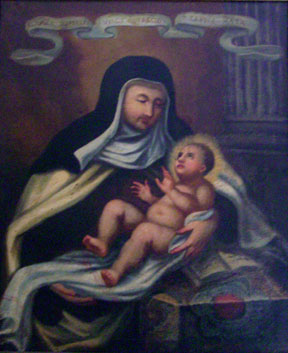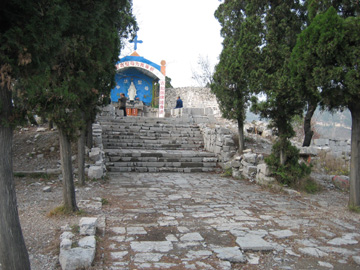|
no. 3 july - september 2007
To reflect on their charism and spirituality, on May 1, 2007, the friars of the Carmelite and Discalced Carmelite Provinces in Malta met for a one day seminar at Tas-Silg retreat house in Marsaxlokk. The Priors Provincial of both Provinces, Fr Alexander Vella O.Carm. and Fr Victor Mallia O.C.D. spoke about contemplation and apostolic life in our life and ministry. The Archbishop of Malta, Mgr. Paul Cremona, O.P., presided over the celebration of the Eucharist, and in his homily, he reflected on the Carmelite Rule and the Blessed Virgin Mary. In small groups, the friars discussed and shared how we are living the Rule in our lives. On Friday May 25, 2007, feast of Saint Mary Magdalen de’ Pazzi, the Carmelites in Malta celebrated the fourth anniversary of the saint’s death at the Carmelite Sanctuary Basilica in Valletta. The Prior Provincial, Alexander Vella, O. Carm., presided over the celebration of the Eucharist, assisted by the Discalced Prior Provincial, Victor Mallia, O.C.D., and friars from the Carmelite and Discalced Carmelite Provinces. Charló Camilleri, O. Carm., delivered the homily. The celebration began by remembering the death of the saint, retelling her last words and nuns’ testimony.
Fire broke out in the oratory housing the Venerable Archconfraternity of Maria S.S. del Carmine in downtown Rome on June 22, 2007. The interior had recently been restored by the members of the confraternity. According to a news release from the Italian Province, various works of art were destroyed. The Rome Fire Department is credited with saving the building and its contents from more extensive damage. According to reports on dietrolanotizia.it, an internet news service, the fire was discovered in the meeting room and in the library. Five fire trucks were sent to the scene. The flames caused heavy smoke damage and had spread to the book shelves. The Archconfraternity is among the oldest in the City of Rome. It is also known as the Arciconfraternita Maria SS. del Carmine alle Tre Cannelle. The cause of the fire has yet to be determined. The Church of Our Lady of Mount Carmel in downtown Rome which houses the Venerable Archconfraternity of Maria S.S. del Carmine. The fire damage was most extensive on the left side of the building. (CITOC foto)
In the Rangoni Chapel of the Cathedral of Reggio Emilia the remains of Blessed Giovanna Scopelli (+1491), foundress of the Carmelite monastery commonly called Le Bianche near the Church of S. Maria del Popolo, are preserved. The mortal remains of the Blessed were moved there in 1803 after the monastery she had founded was suppressed in 1797 and later demolished. During the restauration of the Cathedral, the diocesan bishop, Adriano Caprioli, took the opportunity in December 2005 to restudy the remains of the Blessed and put under the direction of the Diocesan Office of Beni Culturali in cooperation with the offices of the Curia, parishes, interested religious institutes, the Committee for the Restauration of the Cathedral, and public and private groups, "a series of suitable pastoral activies together with some cultural initiatives aimed at making the Blessed and the Church of Reggio Emilia in her time better known." The human and Christian life of the Blessed and the devotion to her were studied through a series of conferences, fruit of the collaboration between the Unione Cattolica Italiana insegnanti Medi, Associazione Italiana Maestri Cattolici and the Ufficio Diocesano Beni Culturali. Such meetings seek to further analyze the situation of the Church of Reggio Emilia at the time of the Blessed. Responsibility for the recognition of the mortal remains of the Blessed was given to a canonical-scientific commission. A number of distinguished Italian scientists served on this commission. Also serving in the capacity of historian and archivist was Carmelite Emmanuele Boaga. Painting of Blessed Giovanna Scopelli. (Courtesy of the Archives of the Carmelite Order)
According to published reports on AsiaNews.it and Zenit.org, a Carmelite shrine in Tianjiaing, China will be dynamited following the government’s finding that the site is a place of illegal religious activity. The annual July 16 th pilgrimage, celebrating the Feast of Our Lady of Mount Carmel, draws some 40,000 people.The shrine was built in 1903 by Mons. Stefano Scarsella, a priest of the Pontifical Institute for Foreign Missions (PIME), who was then apostolic administrator of the northern part of Henan Province. The shrine was intended to recognize the Virgin Mary’s assistance in preserving the people during the Boxer persecution in 1900. A hundred year old statue of Mary and the 14 Stations of the Cross are to be destoyed. The original shrine, a neo-roman church, was almost completely destroyed by the Japanese in the Second World War and by the Chinese Red Guard in the 1960’s. The shrine took on new life in 1979 with faithful coming long distances for solemn liturgies and pilgrimages. Since the government decision, 700 soldiers have been mobilized to keep the shrine from being occupied. All roads to the shrine have been closed and pedestrians who approach the area are searched. The Shrine of Our Lady of Mount Carmel in Tianjiaing, China which the government plans to destroy. |
|||||
|
RETURN TO THE INDEX FOR 2007 | RETURN TO THE INDEX FOR THIS ISSUE INDEX OF CARMELITE
WEBSITES |





